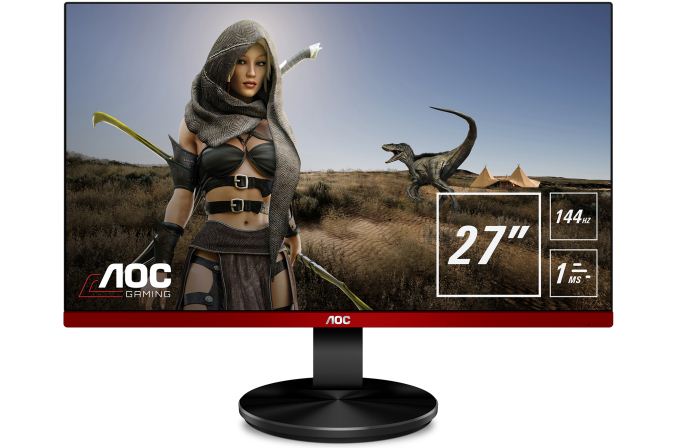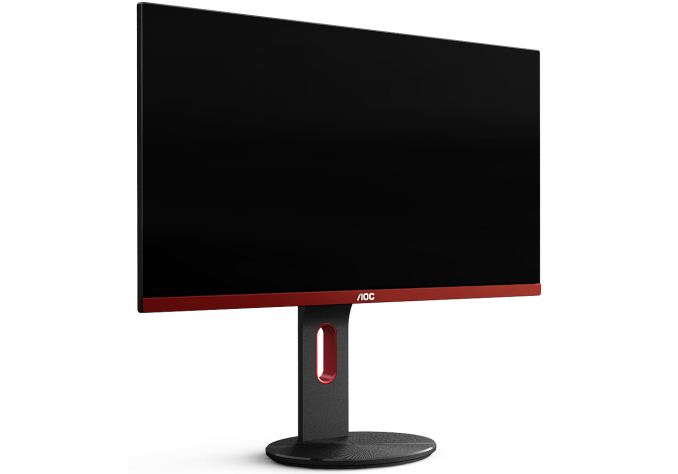Cheap 75-144Hz FreeSync: AOC Unveils G90 Gaming Monitors from €179
by Anton Shilov on December 28, 2017 3:00 PM EST
AOC has introduced its new family of entry-level displays that offer a refresh rate up to 144 Hz, a 1 ms response time, and AMD’s FreeSync technology. The G90 monitors do not belong to the premium AGON lineup designed for serious gamers, but they still take some pages from the AGON book when it comes to design and firmware.
The AOC G90 family consists of three models: the 24.5-inch G2590VXQ, the 24.5-inch G2590PX, and the 27-inch G2790PX. All three are based on TN panels featuring an FHD resolution, 250-400 nits brightness, 1000:1 contrast ratio, 1 ms GtG response time, and 170°/160° horizontal/vertical viewing angles (which is just what you come to expect from inexpensive TN LCDs). All three monitors share a similar design with rather thin bezels and “gaming red” inlays, but there are some differences when it comes to how the stand adjusts. All three support AMD’s FreeSync dynamic refresh rate technology with low framerate compensation (LFC), with a 30-144 Hz range for the G2590PX and G2790PX as well as 30-75 Hz for the cheapest G2590 VXQ. Finally, all three support AOC’s low input lag feature as well as Shadow Control enhancement to make dark scenes brighter.
The G90 lineup from AOC is aimed at a wide audience of gamers and support a variety of inputs, including D-Sub, DisplayPort, HDMI (two of these, probably to simplify connection of game consoles) and even MHL for the 24.5” models.
| Specifications of AOC's G90 Series Gaming Displays | ||||
| G2590VXQ | G2590PX | G2790PX | ||
| Panel | 24.5" TN | 27" TN | ||
| Native Resolution | 1920 × 1080 | |||
| Maximum Refresh Rate | 75 Hz | 144 Hz | ||
| Dynamic Refresh | Tech | AMD FreeSync with LFC | ||
| Range | 30 - 75 Hz | 30 - 144 Hz | ||
| Brightness | 250 cd/m² | 400 cd/m² | ||
| Contrast | 1000:1 | |||
| Viewing Angles | 170°/160° horizontal/vertical | |||
| Response Time | 1 ms GtG | |||
| Pixel Pitch | 0.2825 mm² | 0.3113 mm² | ||
| Pixel Density | 90 PPI | 81 PPI | ||
| Color Gamut Support | sRGB | |||
| Inputs | 1 × DisplayPort 1.2 2 × HDMI 1.4 1 × MHL 1 × D-Sub |
1 × DisplayPort 1.2 2 × HDMI 1.4 1 × D-Sub |
||
| USB Hub | - | 4-port USB hub | ||
| Audio | 2 W × 2 headphone output |
|||
| Proprietary Enhancements | AOC Low Input Lag Shadow Control |
|||
| Power Consumption | Idle | 0.5 W | ||
| Operating | 25 W | 28 W | 32 W | |
| Stand Adjustments | Tilt | -3.5º/19.5º | ||
| Swivel | - | -20º/20º | ||
| Height | - | 130 mm | ||
| Pivot | 90º | |||
| VESA Mounts | 100 × 100 mm | |||
| Launch Timeframe | January 2018 | February 2018 | December 2017 | |
| Launch Price | €179 in Europe £159 in the UK |
€279 in Europe £249 in the UK |
€349 in Europe £309 in the UK |
|
| Additional Information | Link | Link | Link | |
| Check Availability | Amazon.com | Amazon.com | Amazon.com | |
The AOC G2790PX is already available from select retailers in Europe for €349/£309; the G2590X, its younger brother, will hit the market in February and will cost €279/£249. The most affordable G2590VXQ will ship next month with a €179/£159 price tag.
Pricing of the new AOC G90-series monitors in the USA is to be announced at a later date. In the meantime, AOC’s partners are selling off previous-gen gaming monitors with discounts right now. For example, the AOC G2460PF that strongly resembles the G2590PX (24” TN, FHD, 350 nits, 1000:1, 144 Hz, 1 ms GtG, FreeSync, DVI, D-Sub, HDMI, adjustable stand, no Shadow Control) can now be purchased for $205 from Amazon.
Related Reading
- ASUS VA326H and VA326N-W: 31.5-Inch Curved 144 Hz FHD Displays for $399
- Iiyama Unveils Its First Curved Gaming Display: 31.5-inch, FHD, 144 Hz, FreeSync
- AOC to Launch Curved QHD Displays with 0.5 ms Response Time in 2018
- AOC Expands AGON Family with Curved AG322QCX and AG272FCX 144 Hz Displays
- AOC Launches the AG352QCX: 35-Inch 200 Hz 2560×1080 Curved Display with Adaptive-Sync
Source: AOC












25 Comments
View All Comments
Ken_g6 - Thursday, December 28, 2017 - link
Well, this makes AMD video cards look significantly better. The cheapest G-Sync monitor I can find (which also happens to be from AOC) is $300.Sttm - Thursday, December 28, 2017 - link
Yeah, but to be fair the only AMD cards that could actually get you close to that 144 FPS in modern games aren't actually available to buy.Maybe these monitors will serve a RX580 CS GO audience.
silverblue - Thursday, December 28, 2017 - link
Well, the range is 30 to 144, so anything within that and you're fine, no?Samus - Thursday, December 28, 2017 - link
That’s the great thing about variable sync rates. If you have a low performance card you still get the benefit of superior picture quality with no tearing or judder.Diji1 - Thursday, December 28, 2017 - link
So what? There is zero requirements to using Freesync unlike G-sync where certain quality criteria must be met to use it.jordanclock - Thursday, December 28, 2017 - link
It's not just "quality criteria." G-Sync requires Nvidia's FPGA, so there is a very real BoM increase. Freesync will always be cheaper, unless a manufacturer is crazy and tries undercutting Freesync with G-Sync and lose money on each unit.DanNeely - Friday, December 29, 2017 - link
And that's the heart of the matter. FPGA's are great for some things like:1) Rapid prototyping.
2) Low total production volume items (where the cost of an ASIC would be prohibitive)
3) Early time to market with low rate initial production.
They fail massively at high product volumes because they're so much larger, more expensive, and less power efficient than ASICs.
What NVidia needs to do is to work with 1 or more panel controller chip makers and integrate GSync into a conventional ASIC based controller that can be made at prices much closer to what Freesync controllers are selling for.
In an ideal world, they'd just adopt freesync itself and make any features that Gsync does better a superset; but short of VESA making it a required feature instead of optional corporate politics mean it'll never happen.
Cygni - Thursday, December 28, 2017 - link
Headline is pretty misleading. The 179 Euro model maxes at 75hz. Frankly, friends don't let friends buy 24.5in 1080P TN monitors that max at 75hz in 2018, regardless of price.quiksilvr - Thursday, December 28, 2017 - link
But the CG girl with the rocking boobage will make you buy it.Sttm - Thursday, December 28, 2017 - link
Dont worry the EU and UK ad councils will stamp out that sexism!